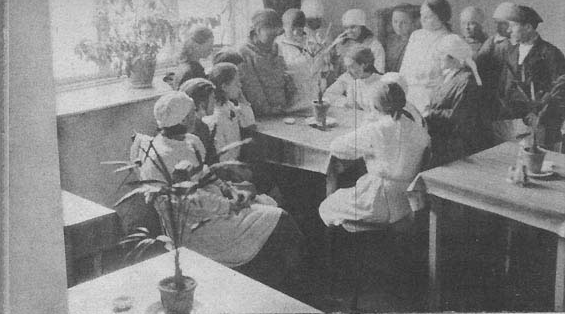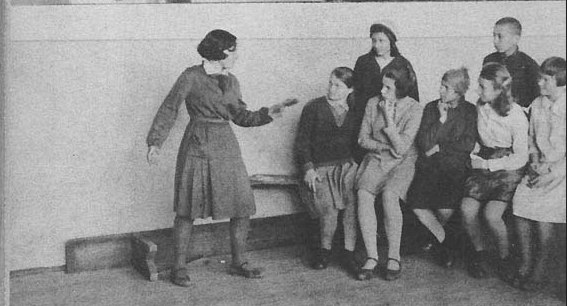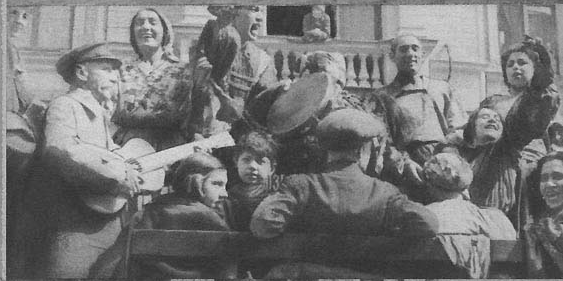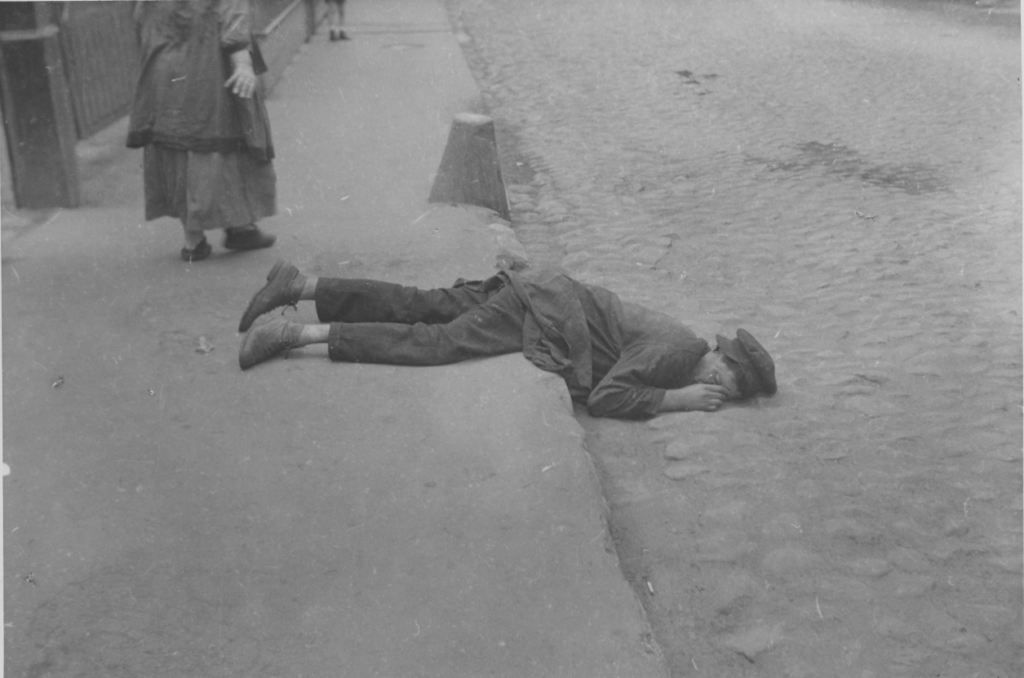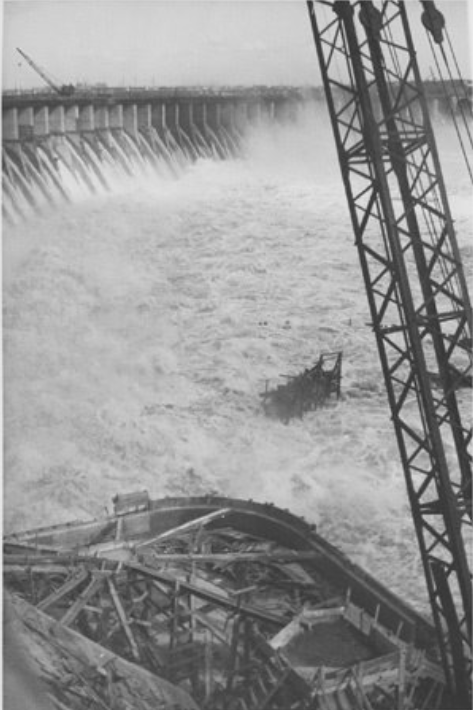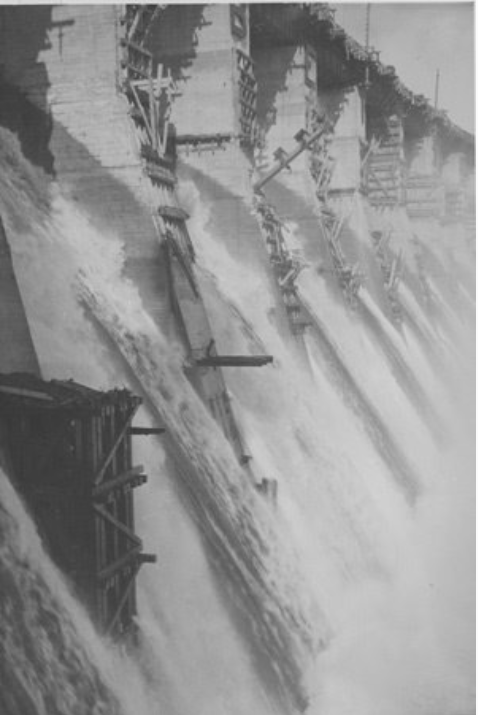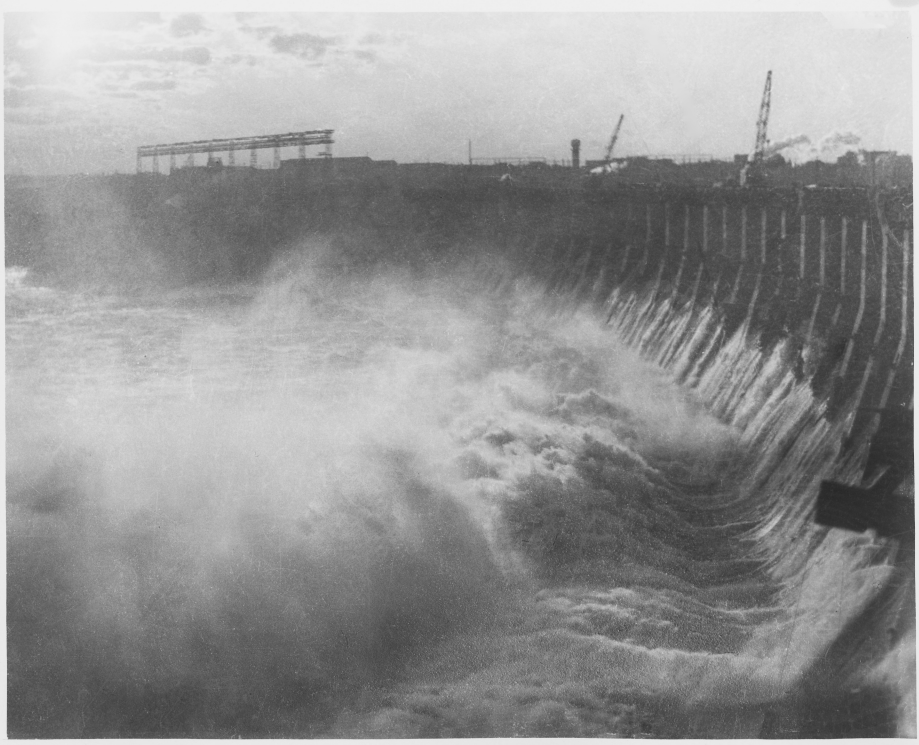James Abbe (July 17, 1883 – November 11, 1973) is a famous American photographer and journalist who cooperated with major American and European publications Vogue, Vanity Fair, The London Magazine, Vu, Berliner Illustrirte Zeitung.
Abbe visited the USSR twice – in 1927 and 1932. During the second trip, he visited Ukraine, in particular Kharkiv, Donetsk region, and Dniprobud.
The American wrote the book “I photograph Russia” about his impressions from the trip, published in New York in 1934. In it, the author drew attention to the facts of famine in Ukraine. During his stay in Kharkiv, Abbe managed to communicate with ordinary citizens. After these conversations, the journalist realized that Ukrainians were hostile to the Stalinist regime and supported Ukraine’s exit from the USSR. While in Ukraine, he clearly understood the difference between Ukrainians and Russians.
In the chapter “Banquets and hunger”, the author very aptly emphasized the inequality in the USSR, comparing the life of the top party and GPU with the hungry everyday life of ordinary workers and peasants.
Abbe tried to distinguish the specially created “Potemkin villages” for foreigners, which were limited to a hotel for foreign guests, a demonstration collective farm or a school, from the reality in which poverty and hunger reigned.
The book also traces the mockery of the Soviet propaganda system, which formed a parallel reality incomparable to real life. The photographer often quotes residents with whom he spoke. For instance, one “old aristocrat” said in French about DniproHES: “Certainly a Red triumph and why not? It was built on the blood of peasants!”
While being in the Donetsk region and talking to workers, the journalist noted: “I have heard eyewitness stories of scenes in the streets of many Ukrainian villages whereinert figures lie in the gutters, not drunk nor sleeping but dead of starvation. And the crowds of people on the streets take no more notice of the dead bodies than we would of a fire hydrant in America.” The photographer was also impressed by the number of hungry people and beggars at the station in Kharkiv.
The book contains photos from James Abbe’s trip to the USSR. Some of them are available on our page.
Also, in the last chapter of the book, the author talks about the photos that he did not take. This is, for instance, a picture of the arrest of Ukrainian peasants by the GPU and a crumpled corpse lying on the roadside in a picturesque Ukrainian village not far from Dniprobud.
Photos published on this page courtesy of the James Abbe Archive.
Please contact the James Abbe Archive in order to obtain a license to use the photo.
Photo captions from the book “I photograph Russia”.
Author of the text: Mykhailo Kostiv, head of the Genocide, Crimes Against Humanity and War Crimes Research Department.
"Long live the world revolution," say posters as Soviet workers march through the Red Square. A world revolution would undoubtedly hold if industry everywhere worked as it does in Russia. AbbeArchive / https://www.jamesabbe.com
While periodical stalls are too limited to attract many buyers, book stalls attract many, especially university students. AbbeArchive / https://www.jamesabbe.com
FORBIDDEN. I was arrested for taking this railway scene. Starved peasants wait weeklong for trains to some objective they vainly imagine is the Promised Land where they may find enough food to keep alive. AbbeArchive / https://www.jamesabbe.com
Imported foreign engineers agree that the women workers are far more efficient and dependable than the men. A camera reporter who has photographed Hollywood bathing beauties will fill find little pulchritude here but plenty of brawn. AbbeArchive / https://www.jamesabbe.com
FORBIDDEN. Photographing any queue is taboo, especially a food queue. At his risk and peril, the writer caught this view of a line forming he dare not tell how long before the stores opened. AbbeArchive / https://www.jamesabbe.com
The Dnieperstroy Hospital is a thoroughly modern, perfectly equipped institution. Its x-ray room and maternity ward are models of up-to-date organization, its staff enthusiastic and efficient; a Bolshevik triumph. AbbeArchive / https://www.jamesabbe.com
Be it ever so humble….. This picture shows the homes of the workers on the Dnieperstroy dam and, his back turned, the child of one of them. AbbeArchive / https://www.jamesabbe.com
On May Day over a million Red soldiers and workers march compulsorily through Red Square. In the foreground are about two hundred privileged ticket holders: correspondents, journalists, diplomats, capitalists… AbbeArchive / https://www.jamesabbe.com
Balloons may be readily flown at thirty below zero and diminutive Bolsheviks taken out for an airing, through the weight and tightness of the blankets make you wonder if “airing” is the correct word. AbbeArchive / https://www.jamesabbe.com
We have nothing to lose but our chains “is the slogan of the workers on their carefully marshalled and obligatory parades. Filling through Red Square they must look as if they were “breaking their chains”. AbbeArchive / https://www.jamesabbe.com
Pioneers, organized to sell Loan Certificates for the second five-year loan. Subscription is of course voluntary, but Heaven help the man who doesn’t buy at least one, unless he enjoys being practically an outcast! AbbeArchive / https://www.jamesabbe.com
Night over Moscow, a scene of incredible beauty. AbbeArchive / https://www.jamesabbe.com
From the new Moscow Hotel your eye travels over moonlight river to the mighty Kremlin, its many spires and towers etched darkly against a luminous sky. AbbeArchive / https://www.jamesabbe.com
The Kremlin, covering 100 acres and enclosed by a high, stone-battlemented wall 2430 yards in length. Somewhere within the imposing palace on the right are Stalin’s private offices… but where, I am pledged not to tell. AbbeArchive / https://www.jamesabbe.com
Artisans, ruthlessly obliterating immortal names from age-old works of art. For Romanoff, they substitute New Moskow Hotel, and tourist who steal silver spoons for souvenirs are just as happy. AbbeArchive / https://www.jamesabbe.com
Ice appears on the Moskow river only at dawn. People rise early to watch it crash into the bridges, break into shining fragments, shoot high into the air and wash against the walls of the embankment. AbbeArchive / https://www.jamesabbe.com
Coronation Chair in which the last of the czars was crowned. It is in one of the Kremlin churches – the Coronation Church – so called because it was used only for that purpose. AbbeArchive / https://www.jamesabbe.com
The scoop a lifetime even for a hardboiled veteran. Stalin, cold as steel, mysterious and remote, Stalin, the Red Czar, never before or since consented to sit for his portrait. (Reproduced from one of the two pictures ever autographed be Stalin). AbbeArchive / https://www.jamesabbe.com
On the twentieth anniversary of Pravda, the government organ, a parade and giant posters emphasize the fact that “the press must serve as an instrument of socialist instruction”. AbbeArchive / https://www.jamesabbe.com
FORBIDDEN. Accidents are taboo. Here is one on Red Square when Horse Artillery, galloping by at breakneck speed, came to grief. The Chinese sign, duplicated in five languages, reads “Long live the Soviet republics.” AbbeArchive / https://www.jamesabbe.com
Twice annually, May 1 and November 7, 7000 Red soldiers lead a procession of more than a million workers in a forced parade. The group atop Lenin’s tomb, right to left: Kalinin, Ordjanikidze, Voroshilov, Stalin, Molotov and Gorky. AbbeArchive / https://www.jamesabbe.com
Litvinov, stick-up man deluxe of the Old Regime, diplomatic super-salesman of Bolshevism under the new, enfant terrible of Geneva conferences, ex-corset salesman, ex-jailbird, the bigshot Soviet official “never gives interviews.” His huge map of the world forms the background. AbbeArchive / https://www.jamesabbe.com
FORBIDDEN. A harsh GPU official allowed a photographer to immortalize his hostages to fortune in Red Square… One hostage, I may add, frequently exploited a comrade on his capitalist father’s credit. AbbeArchive / https://www.jamesabbe.com
The church in our village of Cliasma, a typical Russian temple. In the cities the few bells that have not been melted may not ring, but in the provinces sixty percent of the churches are still functioning. AbbeArchive / https://www.jamesabbe.com
The suburban newspaper stands where it is extremely improbable that you will find the New York Times, Fortune, or Harper’s Bazaar – and strawberries for sale or at all events for yearning contemplation. AbbeArchive / https://www.jamesabbe.com
On their day off every week Muscovites throng to the athletic grounds for Field Day sports. Strength, skill, speed and endurance are enthusiastically applauded in a country striving for maximum physical development. AbbeArchive / https://www.jamesabbe.com
Religious funeral are prohibited on the streets but tolerated in cemeteries where 100% Bolsheviks never go. In remote regions, beyond the reach of propaganda, peasants mourn their dead at rest in paper-covered coffins. AbbeArchive / https://www.jamesabbe.com
FORBIDDEN. Electric railway in the country, about as important strategically as your suburban trolley. But a rule is a rule; “Thou shalt not photograph” figures prominently in the Soviet decalogue and stations are forbidden ground. AbbeArchive / https://www.jamesabbe.com
On the façade of the Metropole Hotel: the Church stands guard over treasure filched from the exploited masses. Children spreading sweetness and light: reading from left to right, a Russian priest, his swinish colleague. AbbeArchive / https://www.jamesabbe.com
The director of the anti-religious museum in the ancient Don Monastery near Moscow. He sits in the Father Superior’s chair, at his desk – with how different a mission! AbbeArchive / https://www.jamesabbe.com
Comrade Smirdovitch, Soviet anti-Christ, director-general of anti-religious activities. From his study wall, his shadow extends over the land of Russia to dim the light by which men have lived for twenty centuries. AbbeArchive / https://www.jamesabbe.com
Worshippers in a church within a stone’s throw from the Kremlin. They are chiefly women, for the young manhood of Russia is loathe to associate itself with anything that savors of religion. AbbeArchive / https://www.jamesabbe.com
This church has been closed but its priceless icons and treasures, being largely immovable, warrant its preservation as an art gallery. This unfortunate circumstance has, however, been counteracted by the huge atheistic poster on the right. AbbeArchive / https://www.jamesabbe.com
The hand of a fallen saint raised as if in supplication to Heaven from amid the holocaust created by the anti-religious propaganda of the Soviet Union. AbbeArchive / https://www.jamesabbe.com
Anti-religious museum. The banner informs German tourists that the battle against religion is the battle for socialism. The grotesque figure, a bishop, served in a burlesque of Christianity in a famous Moscow theatre. AbbeArchive / https://www.jamesabbe.com
Soviet daughters may hang their clothes on the hickory limb and women and men may bathe practically together – but the former will be upstream, the latter down. AbbeArchive / https://www.jamesabbe.com
Дерев'яні різьблені статуї Христа із трьох ліквідованих церков. Темна пляма на піднятій руці центральної фігури - місце, де її століттями цілували селяни. «Абсурдно та антисанітарно», - стверджує влада. AbbeArchive / https://www.jamesabbe.com
Jew as well as Christian has had his temple defiled, his altar “liquidated”. Here is a collection of sacred Jewish relics figuring among other “superstitions” in an anti-religious museum. AbbeArchive / https://www.jamesabbe.com
Fantasy, illusion, the supernatural are permitted to be suggested only in Stanislavsky’s Moskow Art Theatre. Realism and materialism are the two great tenets of Bolshevik belief. This scene is from Maeterlinck’s Bluebird. AbbeArchive / https://www.jamesabbe.com
In contrast to capitalistic notions of amusement, the scene pictured here is not offered on the stage to a charmed public but rather back stage to a delighted photographer. AbbeArchive / https://www.jamesabbe.com
Old soldier never die… they retire, if ex-prisoners of pre-revolutionary days, to a luxurious home. These are not all Communists, but veterans who dreamed, struggled, plotted and threw bombs in Czarist days. AbbeArchive / https://www.jamesabbe.com
A famous cabaret in Moscow, now a peasant home. It is always crowded to capacity, this Beau Geste of the Soviets to the peasants who have toed the Red line. (No others are admitted.) AbbeArchive / https://www.jamesabbe.com
If his horse wins and if he can collect his winnings, your Soviet racing fan may indulge in the national dream of pleasure; the bourgeois luxury of stuffing himself full of food.AbbeArchive / https://www.jamesabbe.com
FORBIDDEN. Another daring photograph: it’s military and it discloses of Catherine the Great, next a kind of harem for Czarist officials, the building in the Background now houses the Academy of Military Aviation. AbbeArchive / https://www.jamesabbe.com
A company of Red aviators, Russia’s crack troops, on parade in front of headquarters building. The second story room on the corner was Napoleon’s bed-chamber when he visited Moskow in 1812. AbbeArchive / https://www.jamesabbe.com
The ballroom where Catherine the Great reveled with her lovers is now the Social Hall of the Academy of Military Aviation. A pleasant place to relax in after a day’s intensive study of Liberty motors. AbbeArchive / https://www.jamesabbe.com
No musical comedy soldier, this, but Comrade Major Sumarakova, the only military aviatrix in the Red Army and commandant of an experimental station which includes a battalion of male pilots. She’s marvelous! AbbeArchive / https://www.jamesabbe.com
FORBIDDEN. Once again, a photograph caused your photographer’s arrest. Why? Because this portrays a railway scene. Note the up-to-date equipment…. The feverish activity … the prosperous, well-clad children. AbbeArchive / https://www.jamesabbe.com
FORBIDDEN. In the Don Basin: one of Russia’s best motor roads. An innocent shot but verboten because photographs of power plants might reveal that they do not function so powerfully as we are led to believe. AbbeArchive / https://www.jamesabbe.com
FORBIDDEN. A clothes queue and not enough clothes to do round. Your photographer once again jeopardized his trusty camera, his mortal neck and his immortal soul to record a prohibited scene. AbbeArchive / https://www.jamesabbe.com
Peasants who drove in form the country to the open market with a little food: potatoes. Unfortunately the prices were too high. There were no buyers, so the potatoes went back to the country. AbbeArchive / https://www.jamesabbe.com
When famine stalks the Land, children are the first to be abandoned. A paternal government adopts them, educates them, fits them for a trade and makes useful little Bolos of them. AbbeArchive / https://www.jamesabbe.com
While the peasant starves, your distinguished foreign visitor fares very nicely… especially if he signs an affidavit stating that he has seen no famine in the Don Basin. AbbeArchive / https://www.jamesabbe.com
Lubyanka Square – a forbidden photograph. An officer of the GPU stood just off the left of the picture. They are destroying the ancient Chinese Wall and would destroy everything else but for valuta visitors who like to see old things. AbbeArchive / https://www.jamesabbe.com
FORBIDDEN. GPU lined up outside the Kremlin Wall. In the background, the monument to the memory of John Reed, American Communist, who lies buried within, cheek by jowl with Lenin. AbbeArchive / https://www.jamesabbe.com
White Elephants of the Kremlin: the biggest bell and biggest cannon in the world. Exhibit A crashed to the ground before fired because of faulty construction. AbbeArchive / https://www.jamesabbe.com
FORBIDDEN. Madame Stalin’s funeral. Below, soldiers; on every roof, sharpshooters with leveled rifles. Orders were to fire if a window were opened. I took fifteen chances on my life in taking as many shots from the Grand Hotel. AbbeArchive / https://www.jamesabbe.com
Building socialism means destroying very many things, whether the entire courtyard of the famous old Winter Palace in Leningrad (the beautiful gateway goes next!) or just another condemned church. AbbeArchive / https://www.jamesabbe.com
Occasionally the most confirmed skeptic must take this hat off to the Bolos for a first-rate job. Here is the Ukrainian government building at Kharkov – a beautiful piece of architecture. AbbeArchive / https://www.jamesabbe.com
On the campus at dear old Moscow. Whether cramming al fresco for their examinations or lunching in the commons of the university, students and co-eds are much the same the whole world over.
Waitress learning their job in the model restaurant of a combine factory. AbbeArchive / https://www.jamesabbe.com
A young Komsomola coaching Soviet children in dramatics. AbbeArchive / https://www.jamesabbe.com
A country group brought to town by the government for a May Day celebration. AbbeArchive / https://www.jamesabbe.com
The Anthropological Museum of Moscow University boasts the largest and most varied collection of human skulls in the world. Here we find workers cataloguing a few soldiers of another war. AbbeArchive / https://www.jamesabbe.com
Enemies of the Five Year Plan, reading left to right: top row – Bureaucret Moujik, Foreign Journalist, Capitalist; bottom row – Drunkard, Priest, Menshevik, Military Engineer. While the new Russian machinery forges ahead under the slogan “Destroy Sectarian Chicanery.” … AbbeArchive / https://www.jamesabbe.com
A man is lying on the road (dead?).. AbbeArchive / https://www.jamesabbe.com
Photo of DniproHES. Without author's description. AbbeArchive / https://www.jamesabbe.com
Photo of DniproHES. Without author's description. AbbeArchive / https://www.jamesabbe.com
Photo of DniproHES. Without author's description. AbbeArchive / https://www.jamesabbe.com
Photo of DniproHES. Without author's description. AbbeArchive / https://www.jamesabbe.com




























































